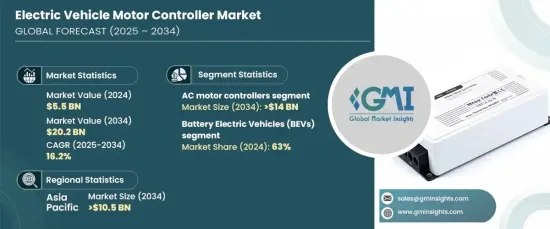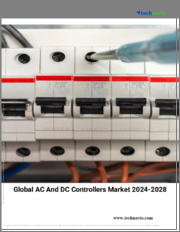
|
시장보고서
상품코드
1665062
전기자동차용 모터 컨트롤러 시장 기회, 성장 촉진요인, 업계 동향 분석 및 예측(2025-2034년)Electric Vehicle Motor Controller Market Opportunity, Growth Drivers, Industry Trend Analysis, and Forecast 2025 - 2034 |
||||||
세계의 전기자동차용 모터 컨트롤러 시장은 2024년 55억 달러에 이르렀으며, 2025년부터 2034년까지 연평균 복합 성장률(CAGR) 16.2%로 강력한 성장이 예상됩니다.
이러한 시장의 급속한 확대는 환경 의식 증가와 지속 가능한 운송 솔루션으로의 전환의 가속화가 원동력이 되고 있습니다. 세계 정부와 조직은 엄격한 배출 규제를 도입함과 동시에 전기자동차(EV)의 도입을 장려하는 인센티브와 보조금을 제공해 모터 컨트롤러 분야의 성장을 더욱 촉진하고 있습니다.

시장은 주로 모터의 유형에 따라 AC 모터 컨트롤러와 DC 모터 컨트롤러로 구분됩니다. 2024년에는 AC 모터 컨트롤러가 시장의 대부분을 차지해 70%의 점유율을 차지했습니다. 이러한 이점은 앞으로도 계속될 것으로 예상되며, AC 모터 컨트롤러는 2034년까지 140억 달러를 창출할 것으로 예상됩니다. AC 모터 컨트롤러가 선호되는 것은 특히 DC 모터 컨트롤러에 비해 뛰어난 효율성, 고성능 및 우수한 유연성 때문입니다. 동기식 및 비동기식 AC 모터는 모두 토크 제어를 개선하고 고출력을 제공하며 최신 세대의 전기자동차에 이상적인 선택입니다.
| 시장 범위 | |
|---|---|
| 시작 연도 | 2024년 |
| 예측 연도 | 2025-2034년 |
| 시작 금액 | 55억 달러 |
| 예측 금액 | 202억 달러 |
| CAGR | 16.2% |
차종별로 전기자동차용 모터 컨트롤러 시장은 플러그인 하이브리드 자동차(PHEV), 하이브리드 자동차(HEV), 배터리 전기자동차(BEV)로 구분됩니다. 2024년에는 BEV가 시장을 선도해 63%의 점유율을 차지했습니다. 이 이점은 BEV가 추진력을 전기 모터에 완전히 의존하고 제로 방출의 운송 수단으로 선호되는 옵션이기 때문입니다. BEV의 채용 증가는 세계의 지속가능성에 대한 노력과 환경기준에 부합하여 전기자동차용 모터 컨트롤러 수요를 촉진하고 있습니다.
아시아태평양은 전기자동차용 모터 컨트롤러 시장에서 주도권을 유지하고 2024년에는 시장 점유율의 50%에 기여했습니다. 이 지역은 견고한 전기자동차 제조 생태계와 세제 우대 조치, 보조금, 야심찬 전기화 목표 등의 지원적인 정부 정책에 의해 지원되며, 2034년까지 105억 달러를 창출할 것으로 예상됩니다. 게다가 배터리 기술과 파워 일렉트로닉스의 지속적인 발전은 효율적인 모터 컨트롤러의 생산을 강화하고 시장의 꾸준한 성장에 박차를 가하고 있습니다. 충전 인프라의 확대와 보다 깨끗하고 지속가능한 교통수단에 대한 소비자 수요 증가는 전기자동차용 모터 컨트롤러 시장에서 아시아태평양의 주요 기업으로서의 입지를 더욱 견고하게 하고 있습니다.
목차
제1장 조사 방법과 조사 범위
- 조사 디자인
- 조사 접근
- 데이터 수집 방법
- 기본 추정과 계산
- 기준연도의 산출
- 시장추계의 주요 동향
- 예측 모델
- 1차 조사와 검증
- 1차 정보
- 데이터 마이닝 소스
- 시장 정의
제2장 주요 요약
제3장 업계 인사이트
- 생태계 분석
- 공급자의 상황
- 반도체 제조업체
- 파워 일렉트로닉스 모듈 제조업체
- EVMC 시스템 통합
- OEM
- Tier 1 공급업체
- 이익률 분석
- 특허 상황
- 주요 모터 컨트롤러 기술의 비교 분석(AC 대 DC 컨트롤러)
- 회생 제동과 에너지 효율 혁신
- 기술과 혁신의 전망
- 주요 뉴스와 대처
- 규제 상황
- 영향요인
- 성장 촉진요인
- 환경 문제에 대한 우려로 전기자동차 수요 증가
- 세계 각국의 정부에 의한 배출가스와 연비 규제 강화
- 모터 및 컨트롤러 기술의 진보
- EV 충전 네트워크 확대 및 지원 정책
- 업계의 잠재적 위험 및 과제
- 고비용의 배터리
- 한정된 원재료의 이용가능성
- 성장 촉진요인
- 성장 가능성 분석
- Porter's Five Forces 분석
- PESTEL 분석
제4장 경쟁 구도
- 서론
- 기업 점유율 분석
- 경쟁 포지셔닝 매트릭스
- 전략 전망 매트릭스
제5장 시장 추계·예측 : 모터별(2021-2034년), 10억 달러
- 주요 동향
- AC 모터 컨트롤러
- 동기 모터
- 비동기 모터
- DC 모터 컨트롤러
- 브러시 모터
- 브러시리스 모터
제6장 시장 추계·예측 : 출력별(2021-2034년), 10억 달러
- 주요 동향
- 1-20 kW
- 21-40 kW
- 41-80 kW
- 80kW 이상
제7장 시장 추계·예측 : 차량별(2021-2034년), 10억 달러
- 주요 동향
- 배터리 전기자동차(BEV)
- 플러그인 하이브리드 자동차(PHEV)
- 하이브리드 전기자동차(HEV)
제8장 시장 추계·예측 : 최종 용도별(2021-2034년), 10억 달러
- 주요 동향
- OEM
- 애프터마켓
제9장 시장 추계·예측 : 지역별(2021-2034년), 10억 달러
- 주요 동향
- 북미
- 미국
- 캐나다
- 유럽
- 영국
- 독일
- 프랑스
- 스페인
- 이탈리아
- 러시아
- 북유럽
- 아시아태평양
- 중국
- 인도
- 일본
- 한국
- 뉴질랜드
- 동남아시아
- 라틴아메리카
- 브라질
- 멕시코
- 아르헨티나
- 중동 및 아프리카
- UAE
- 남아프리카
- 사우디아라비아
제10장 기업 프로파일
- Analog Devices
- BorgWarner
- BYD Company
- Continental
- Curtiss-Wright
- Denso
- Hitachi Astemo
- Infineon Technologies
- LG Electronics
- Magna International
- Microchip Technology
- Mitsubishi Electric
- Nidec
- Renesas Electronics
- Robert Bosch
- Siemens
- STMicroelectronics
- Tesla
- Valeo
- ZF Friedrichshafen
The Global Electric Vehicle Motor Controller Market reached USD 5.5 billion in 2024 and is expected to experience robust growth at a CAGR of 16.2% from 2025 to 2034. This surge in market expansion is driven by increasing environmental awareness and the accelerating shift toward sustainable transportation solutions. Governments and organizations across the world are introducing stringent emissions regulations, as well as offering incentives and subsidies to encourage electric vehicle (EV) adoption, further propelling growth in the motor controller sector.

The market is primarily segmented by motor type into AC motor controllers and DC motor controllers. In 2024, AC motor controllers dominate the market, capturing a significant 70% share. This dominance is anticipated to continue, with AC motor controllers projected to generate USD 14 billion by 2034. The preference for AC motor controllers is due to their superior efficiency, high performance, and exceptional flexibility, especially in comparison to DC motor controllers. Both synchronous and asynchronous AC motors provide improved torque control and higher power output, making them an ideal choice for the latest generation of electric vehicles.
| Market Scope | |
|---|---|
| Start Year | 2024 |
| Forecast Year | 2025-2034 |
| Start Value | $5.5 Billion |
| Forecast Value | $20.2 Billion |
| CAGR | 16.2% |
In terms of vehicle type, the electric vehicle motor controller market is divided into Plug-in Hybrid Electric Vehicles (PHEVs), Hybrid Electric Vehicles (HEVs), and Battery Electric Vehicles (BEVs). In 2024, BEVs are expected to lead the market, holding a 63% share. This dominance is attributed to BEVs' complete reliance on electric motors for propulsion, positioning them as the preferred choice for zero-emission transportation. The rising adoption of BEVs aligns with global sustainability initiatives and environmental standards, driving the demand for electric vehicle motor controllers.
Asia Pacific is set to maintain its leadership in the electric vehicle motor controller market, contributing 50% of the market share in 2024. The region is expected to generate USD 10.5 billion by 2034, underpinned by a robust EV manufacturing ecosystem and supportive government policies such as tax incentives, subsidies, and ambitious electrification targets. Furthermore, continuous advancements in battery technology and power electronics enhance the production of efficient motor controllers, fueling steady market growth. The expansion of charging infrastructure and rising consumer demand for cleaner, more sustainable transportation further solidify Asia Pacific's position as a key player in the electric vehicle motor controller market.
Table of Contents
Chapter 1 Methodology & Scope
- 1.1 Research design
- 1.1.1 Research approach
- 1.1.2 Data collection methods
- 1.2 Base estimates and calculations
- 1.2.1 Base year calculation
- 1.2.2 Key trends for market estimates
- 1.3 Forecast model
- 1.4 Primary research & validation
- 1.4.1 Primary sources
- 1.4.2 Data mining sources
- 1.5 Market definitions
Chapter 2 Executive Summary
- 2.1 Industry 3600 synopsis, 2021 - 2034
Chapter 3 Industry Insights
- 3.1 Industry ecosystem analysis
- 3.2 Supplier landscape
- 3.2.1 Semiconductor manufacturers
- 3.2.2 Power electronics module manufacturers
- 3.2.3 EVMC system integrators
- 3.2.4 OEMs (Original Equipment Manufacturers)
- 3.2.5 Tier-1 suppliers
- 3.3 Profit margin analysis
- 3.4 Patent landscape
- 3.5 Comparative analysis of key motor controller technologies (AC vs. DC controllers)
- 3.6 Innovations in regenerative braking and energy efficiency
- 3.7 Technology & innovation landscape
- 3.8 Key news & initiatives
- 3.9 Regulatory landscape
- 3.10 Impact forces
- 3.10.1 Growth drivers
- 3.10.1.1 Increasing demand for electric vehicles due to environmental concerns
- 3.10.1.2 Governments worldwide are imposing stricter emissions and fuel efficiency standards
- 3.10.1.3 Technological advancements in motor controller technologies
- 3.10.1.4 Expansion of EV charging networks and supportive policies
- 3.10.2 Industry pitfalls & challenges
- 3.10.2.1 The high cost of batteries
- 3.10.2.2 Limited raw material availability
- 3.10.1 Growth drivers
- 3.11 Growth potential analysis
- 3.12 Porter’s analysis
- 3.13 PESTEL analysis
Chapter 4 Competitive Landscape, 2024
- 4.1 Introduction
- 4.2 Company market share analysis
- 4.3 Competitive positioning matrix
- 4.4 Strategic outlook matrix
Chapter 5 Market Estimates & Forecast, By Motor, 2021 - 2034 ($Bn, Units)
- 5.1 Key trends
- 5.2 AC motor controllers
- 5.2.1 Synchronous motors
- 5.2.2 Asynchronous motors
- 5.3 DC motor controllers
- 5.3.1 Brushed motors
- 5.3.2 Brushless motors
Chapter 6 Market Estimates & Forecast, By Power Output, 2021 - 2034 ($Bn, Units)
- 6.1 Key trends
- 6.2 1-20 kW
- 6.3 21-40 kW
- 6.4 41-80 kW
- 6.5 Above 80 kW
Chapter 7 Market Estimates & Forecast, By Vehicle, 2021 - 2034 ($Bn, Units)
- 7.1 Key trends
- 7.2 Battery Electric Vehicles (BEV)
- 7.3 Plug-in Hybrid Electric Vehicles (PHEV)
- 7.4 Hybrid Electric Vehicles (HEV)
Chapter 8 Market Estimates & Forecast, By End Use, 2021 - 2034 ($Bn, Units)
- 8.1 Key trends
- 8.2 OEM
- 8.3 Aftermarket
Chapter 9 Market Estimates & Forecast, By Region, 2021 - 2034 ($Bn, Units)
- 9.1 Key trends
- 9.2 North America
- 9.2.1 U.S.
- 9.2.2 Canada
- 9.3 Europe
- 9.3.1 UK
- 9.3.2 Germany
- 9.3.3 France
- 9.3.4 Spain
- 9.3.5 Italy
- 9.3.6 Russia
- 9.3.7 Nordics
- 9.4 Asia Pacific
- 9.4.1 China
- 9.4.2 India
- 9.4.3 Japan
- 9.4.4 South Korea
- 9.4.5 ANZ
- 9.4.6 Southeast Asia
- 9.5 Latin America
- 9.5.1 Brazil
- 9.5.2 Mexico
- 9.5.3 Argentina
- 9.6 MEA
- 9.6.1 UAE
- 9.6.2 South Africa
- 9.6.3 Saudi Arabia
Chapter 10 Company Profiles
- 10.1 Analog Devices
- 10.2 BorgWarner
- 10.3 BYD Company
- 10.4 Continental
- 10.5 Curtiss-Wright
- 10.6 Denso
- 10.7 Hitachi Astemo
- 10.8 Infineon Technologies
- 10.9 LG Electronics
- 10.10 Magna International
- 10.11 Microchip Technology
- 10.12 Mitsubishi Electric
- 10.13 Nidec
- 10.14 Renesas Electronics
- 10.15 Robert Bosch
- 10.16 Siemens
- 10.17 STMicroelectronics
- 10.18 Tesla
- 10.19 Valeo
- 10.20 ZF Friedrichshafen


















